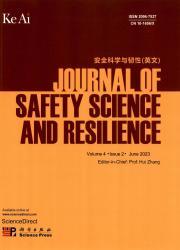推进危险材料运输安全:对风险、挑战和研究差距的系统见解
IF 3.4
Q1 PUBLIC, ENVIRONMENTAL & OCCUPATIONAL HEALTH
引用次数: 0
摘要
危险材料(Hazmat)的运输对供应链至关重要,但也带来了重大的安全风险,导致严重的人类、环境和财务影响。本研究系统回顾了1970年至2022年的2078份出版物,重点关注危险物品运输安全的趋势、挑战和研究差距。通过文献计量学和系统审查方法,确定了调查的关键领域,如风险管理、安全路线和应急响应。建立了一个强有力的国际合作网络,特别强调风险管理。然而,关键的主题,如人为因素、弹性工程和安全性,被发现没有得到充分的探索。尽管在风险评估方面取得了进展,但在处理动态风险和使用真实世界数据改进模型验证方面仍然存在重要差距。此外,得出的结论是,未来的研究应在加强现有方法的同时解决这些差距。这篇综述对当前的研究现状进行了全面的分析,突出了需要进一步探索的领域,并为提高危险品运输系统的安全性和可持续性提供了有价值的见解。研究结果预计将指导未来的研究工作并为政策制定提供信息,最终有助于减少与危险物品运输相关的风险,并在这一重要部门推进更安全的做法。本文章由计算机程序翻译,如有差异,请以英文原文为准。
Advancing hazardous materials transport safety: Systematic insights on risks, challenges, and research gaps
The transportation of hazardous materials (Hazmat) has been essential to supply chains but has posed significant safety risks, resulting in severe human, environmental, and financial impacts. This study systematically reviewed 2078 publications from 1970 to 2022, focusing on trends, challenges, and research gaps in Hazmat transportation safety. Through bibliometric and systematic review methodologies, key areas of investigation, such as risk management, safety routing, and emergency response, were identified. A strong international collaborative network was revealed, with significant emphasis on managing risks. However, critical topics such as human factors, resilience engineering, and security were found to be underexplored. Despite advancements in risk assessment, important gaps remained in addressing dynamic risks and improving model validation using real-world data. Furthermore, it was concluded that future research should address these gaps while enhancing existing methodologies. This review provided a comprehensive analysis of the current research landscape, highlighting areas requiring further exploration and offering valuable insights into improving the safety and sustainability of Hazmat transportation systems. The findings are expected to guide future research efforts and inform policy development, ultimately contributing to the reduction of risks associated with Hazmat transport and advancing safer practices in this essential sector.
求助全文
通过发布文献求助,成功后即可免费获取论文全文。
去求助
来源期刊

安全科学与韧性(英文)
Management Science and Operations Research, Safety, Risk, Reliability and Quality, Safety Research
CiteScore
8.70
自引率
0.00%
发文量
0
审稿时长
72 days
 求助内容:
求助内容: 应助结果提醒方式:
应助结果提醒方式:


